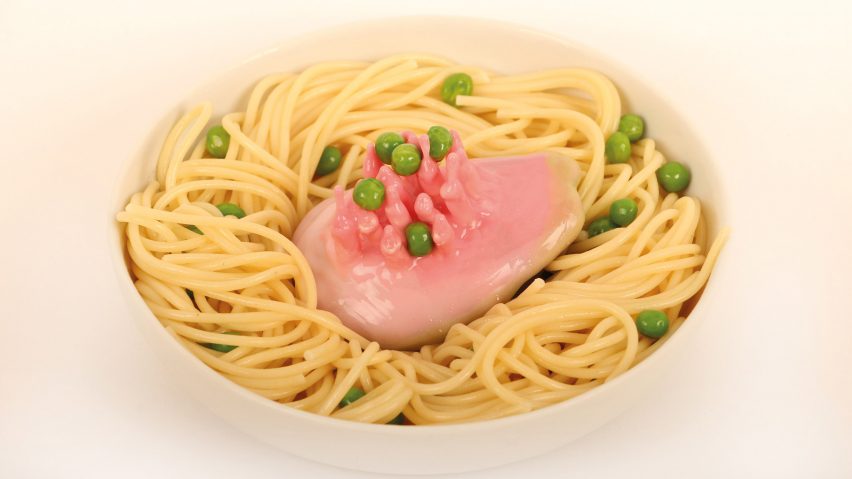Dutch designer Marije Vogelzang has created a series of objects to trick diners into believing their plates are full of food, in a bid to prevent them overeating.
The Volumes collection is an ongoing research project by Vogelzang, who heads up the food design department at Design Academy Eindhoven.
Her aim is to make people realise that they often don't need as much food as they think they do.
Vogelzang's objects are made by coating simple stones with food-safe, heat-resistant silicone. They are designed to be placed in the middle of a plate or bowl, reducing the amount of space for food.
This approach – as opposed to simply offering a smaller plate – is intended to trick the diner into believing there is more food in front of them than there actually is, meaning they are more likely to be satisfied.
"Behavioural research shows that our brain uses our visual capacities to register the amount of food we have eaten," explained Vogelzang.
"For example, if we eat shelled peanuts and leave the shells on the table, we will eat less than if we would take the shells away directly after eating the peanuts."
"The project Volumes is an attempt to influence our eating behaviour and our eating culture," she continued. "By adding volumes to your plate, your brain will register more food than there actually is."
The weight of the plate also plays a part in the trickery, which is why Vogelzang chose to make her objects heavy. They act as "thermal agents" too, to keep cold food cold and hot food hot, encouraging diners to eat at a slower pace.
The strange shapes are intended to visually entice diners, with protruding elements that allow them to interact with the food in unusual ways.
"By giving more attention to the presentation of our food we might be able to change our mindless consumption behaviour into a mindful experience," said the designer.
"Food styling is not just vain aesthetics," she added. "Food styling makes people eat with more care and attention."
"Food is never clean. Messy objects look more edible than perfect clean geometrical shapes."
Vogelzang sees her Volumes objects as the "next step" in tableware, particularly in societies where appetites are getting larger, and portion sizes are increasing all the time.
Her plan is to further develop her objects, creating 3D-printed versions that could be more easily manufactured. She also intends to carry out more tests.
"For centuries most of the tableware china consisted out of plates and bowls," she said.
"These plates and bowls have grown together with our consumption behaviour in the last centuries. We are adding the next step. Volumes to give body to your food and to keep your body healthy."
Vogelzang began exploring the relationship between design and food while studying at Design Academy Eindhoven.
One of her first projects, called White Funeral Meal (1999), involved serving all-white food on white crockery. The aim was to allow mourners to "share a meal and their memories", referencing how white is the colour most associated with death.
She ran an experimental restaurant named Proef from 2004 to 2011, and in 2014 was made the head of the new The Food Non Food department at Design Academy Eindhoven, which was the first course of its type in the world.
"There's so much wrong with food at the moment," Vogelzang told Dezeen at the time of her appointment.
"There's so much going on in the world of food that we need designers to start working on this in a serious way. It is the most rich and important material in the world."
The first exhibition by the Food Non Food students, titled Eat Shit, took place during Milan design week in 2015. Students presented a range of projects investigating both ends of the human digestive system.
Since the course launched, other designs schools have also started looking more closely at food.
A group of graduates from ÉCAL recently devised methods for sustainable meat consumption, while a team of Royal College of Art students aimed to kickstart interest in the "forgotten" process of preserving vegetables with a home fermentation kit.

